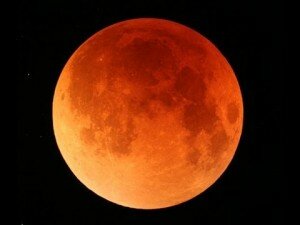 Even if you’re not a STEM aficionado, haven’t taken astronomy, or care more about what’s happening on our little earth than in the sky above, the blood moon total lunar eclipse this weekend was pretty awesome. And if you do love science, or technology or photography or history or engineering or astronomy or math, this eclipse was most likely one of the highlights of your year.
Even if you’re not a STEM aficionado, haven’t taken astronomy, or care more about what’s happening on our little earth than in the sky above, the blood moon total lunar eclipse this weekend was pretty awesome. And if you do love science, or technology or photography or history or engineering or astronomy or math, this eclipse was most likely one of the highlights of your year.
You can read about the eclipse in many, many spots around the World Wide Web, but for those who missed the recap, here’s a quick summary of the lack of light in the skies. On September 27, the Sun, Earth, and Moon formed a straight line (referred to as syzgy, from the Greek word for being together). As you might imagine, this means that the Earth blocks direct sunlight from reaching the moon, so the sun’s light casts the Earth’s shadow on the moon. This covers the entire moon, which is the essence of a lunar eclipse.
There’s a reason that this particular eclipse is so special, though. While lunar eclipses aren’t exactly common (the next one will happen in January of 2019), Sunday’s eclipse coincided with a supermoon, something that hasn’t happened since 1982. A supermoon is what it sounds like: when a full or new moon makes its closest approach to earth, it is considered a supermoon.
David Kriegler of UNO’s physics department told that “although still 222,000 miles away, the full moon will look 30 percent bigger and 30 percent brighter than usual.”
But wait! It gets better! The lunar eclipse also featured a blood moon, meaning that the moon appeared as a brownish reddish color. And finally, , science professor at Western Nebraska Community College, explained that this eclipse was the last in a tetrad: “A tetrad is basically where you have four full lunar eclipses that are consecutive. In this instance, the tetrad is about every six months,” King says. “This one has been unusual because it’s been fully visible in a big chunk of Canada and almost all of North and South America. Half the planet’s going to get to see it.”
While most of Asia and Australia won’t be able to see the eclipse, certain sections of the United States, Canada, Africa, and Europe were able to see the eclipse in its entirety. Lucky Nebraskans came out in droves to watch the event at several host locations around the state, including in Lincoln, Omaha, and Beatrice.
For example, the Homestead National Monument of America in Beatrice hosted viewers in the parking lot: “The parking lot at the Heritage Center is a great place for moon and star viewing…this unique phenomenon doesn’t happen often,” said Superintendent Mark Engler. At UNO, the Durham Science Center opened the observatory and planetarium to interested citizens for free, and even hooked up smartphone adapters to telescopes for photos. UNL’s Behlen Observatory near Mead also stayed open late.
In particular, the moon’s red color endeared it to many Nebraskans, including Shawn Langan, lab manager with the University of Nebraska-Lincoln Physics and Astronomy Department: “I like to call it the Husker moon,” he said.
—
Photo credit:
 Official Nebraska Government Website
Official Nebraska Government Website
